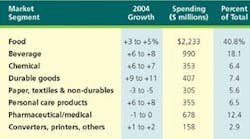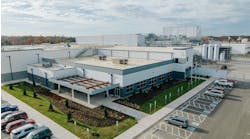It's shaping up to be a pretty good year for packaging equipment sales. The Packaging Machinery Manufacturers Institute (PMMI) predicts a 4.0 percent increase this year, with the food industry doing its part and the beverage category doing even more.
PMMI in January and February surveyed 424 decision-makers responsible for 12,251 packaging lines in 1,814 plants throughout all key segments of theU.S.
In all,U.S.
PMMI in January and February surveyed 424 decision-makers responsible for 12,251 packaging lines in 1,814 plants throughout all key segments of the
In all,
Figure 1: Packaging machinery's annual growth, in percent.
As figure 1 shows, the predicted 2004 growth follows two successive year gains after the downturn in 2001. PMMI considers this confirmation that the recovery now in progress is indeed genuine. In addition to the emergence of generally favorable economic developments that are providing end users with the well-needed confidence to commit capital funds for investment in machinery and equipment, corporate profits are rising substantially and optimism within the market continues to improve, the association says.
Of the eight defined market segments studied, six -- beverages, chemicals, durables, foods, personal care and converters , are expected to increase expenditures for packaging machinery this year (see figure 2). They collectively account for more than 81 percent of the machinery industry's annual dollar volume.
Conversely, machinery sales to the non-durables/soft goods and pharmaceuticals/medical products segments are forecast to be off slightly; although the volume of demand to the pharmaceutical/medical products segment will nevertheless remain substantial , at or near last year's level.
As figure 1 shows, the predicted 2004 growth follows two successive year gains after the downturn in 2001. PMMI considers this confirmation that the recovery now in progress is indeed genuine. In addition to the emergence of generally favorable economic developments that are providing end users with the well-needed confidence to commit capital funds for investment in machinery and equipment, corporate profits are rising substantially and optimism within the market continues to improve, the association says.
Of the eight defined market segments studied, six -- beverages, chemicals, durables, foods, personal care and converters , are expected to increase expenditures for packaging machinery this year (see figure 2). They collectively account for more than 81 percent of the machinery industry's annual dollar volume.
Conversely, machinery sales to the non-durables/soft goods and pharmaceuticals/medical products segments are forecast to be off slightly; although the volume of demand to the pharmaceutical/medical products segment will nevertheless remain substantial , at or near last year's level.
Figure 2: How the segments are doing.
At the time of the interviews, 33 percent of the respondents reported plans to spend more on packaging machinery this year than last, and 28.7 percent indicated they intend to spend less.
Of significant note, PMMI says, those planning to allocate roughly the same dollar amount as in 2003 fell to 32.5 percent from 34 percent in the prior year. This is the first year since the inception of the Purchasing Plans Study that the "no-change in spending" group did not represent the clear plurality of respondents, a development that possibly signals a shift away from the pervasive mood of extreme caution that has plagued the market for many years. By the same token, PMMI cautions, the data also suggest the market is not yet fully out of the woods, as reflected in the fact that the proportion of companies/plants expecting to spend less for machinery in 2004 (28.7%) is actually higher than the 27 percent recorded last year. Moreover, as reported in 2003, while the majority of end users look ahead to the future with optimism, many also still remain concerned about economic and geopolitical uncertainties clouding the market environment. Nevertheless, the abundance of positive factors expected to influence demand for packaging machinery in 2004 clearly outweighs the presence of lingering negatives.
At the time of the interviews, 33 percent of the respondents reported plans to spend more on packaging machinery this year than last, and 28.7 percent indicated they intend to spend less.
Of significant note, PMMI says, those planning to allocate roughly the same dollar amount as in 2003 fell to 32.5 percent from 34 percent in the prior year. This is the first year since the inception of the Purchasing Plans Study that the "no-change in spending" group did not represent the clear plurality of respondents, a development that possibly signals a shift away from the pervasive mood of extreme caution that has plagued the market for many years. By the same token, PMMI cautions, the data also suggest the market is not yet fully out of the woods, as reflected in the fact that the proportion of companies/plants expecting to spend less for machinery in 2004 (28.7%) is actually higher than the 27 percent recorded last year. Moreover, as reported in 2003, while the majority of end users look ahead to the future with optimism, many also still remain concerned about economic and geopolitical uncertainties clouding the market environment. Nevertheless, the abundance of positive factors expected to influence demand for packaging machinery in 2004 clearly outweighs the presence of lingering negatives.
Figure 3: Why they're spending.
There were 11 identified reasons why respondents planned on spending more on packaging machinery:
? Customers continue to replace older packaging machines with new models. Replacement of older machinery with current higher-tech models remains a priority in the market; for customers have overwhelmingly come to recognize the value of the new technology as a vehicle for improving productivity. Therefore, a large number of packaging machines will be targeted for replacement in 2004, as they were in 2003. "We're looking to gain a competitive edge through increased productivity by incorporating new machinery into our lines," said a manufacturer of toothpaste and oral care products. "Our plant is replacing machinery this year specifically to avoid downtime caused by breakdowns," added a beverage bottler.
? New machines are being added to expand automation and reduce labor costs. Fifteen percent of those ordering machines this year cited the need to expand automation and reduce labor costs as the primary reason for installing new packaging machinery. "Our company is determined to automate the configuration of our existing packaging lines this year; they're much too labor-intensive," said a maker of clinical foods and vitamin products.
? There is a gradually emerging need for expanded packaging capacity. Despite the market's relatively limited success in reducing excess packaging capacity, emerging requirements for additional capacity have nonetheless prompted the need for new packaging machines to be installed in selective areas.
? Accelerated depreciation tax write-offs for new equipment are helping. Though not widely mentioned by respondents, the accelerated depreciation deduction contained in the "Job Creation and Workers Assistance Act of 2003" allows an up-front tax break of 50 percent on all equipment ordered and put in service by the end of 2004.
? Changeovers are becoming more frequent. End users are operating an increasing number of packaging runs owing to the proliferation of product varieties, product sizes and product configurations that packagers must handle on the same packaging lines. Therefore, the need for greater flexibility to handle the dissimilarities as well as to speed changeovers is growing rapidly.
? New products and SKUs are planned for 2004. Roughly 10 percent of the sample claimed they are ordering new packaging machinery this year primarily to handle the addition of new products and SKUs to their lines. While the full impact of this factor on machinery demand will not be realistically measurable until later in the year (since many of the new introductions are not known at the plant or engineering level until near release time), anecdotal evidence and secondary research suggest that the rate of introductions will exert a higher impact than the 10 percent figure might indicate. In fact, food companies scrambling to capitalize on the low-carb diet fad will generate much of the new-product activity.
? Super stores and large retail chains continue to impact packaging requirements. Nearly 61 percent of the total sample's respondents (including 69 percent of the food sample) reported that their customers, particularly the food super stores and food chains, exert a major impact on their packaging machinery order decisions, and 47.8 percent indicated that their influence is increasing. Both of these numbers are up compared with 2003. In many instances that influence necessitates the installation of a new machine to accommodate a particular requirement.
? New and different package designs, shapes, sizes and materials continuing to be adopted by customers. Whether to reduce package cost, improve product shelf appeal, improve ease of product handling for consumers, or to conform to major customers' packaging requirements, there are shifts to alternative package designs, sizes, materials, and configurations.
? Underlying consumer trends have positive effects. Several underlying trends will indirectly play key roles in sustaining growth in packaging machinery demand this year, including changing demographics, the low-carb diet trend, consumers' increasing preference for convenience foods and a growing health-conscious population.
? More attention is being paid to ergonomics, product security, and safety issues. For 2004, approximately 6 percent of those ordering machinery reported worker ergonomics, safety, and or product security as one of their main reasons for ordering packaging machinery this year.
? Don't forget RFID implementation. Based on requirements set forth by several majorU.S.
There were 11 identified reasons why respondents planned on spending more on packaging machinery:
? Customers continue to replace older packaging machines with new models. Replacement of older machinery with current higher-tech models remains a priority in the market; for customers have overwhelmingly come to recognize the value of the new technology as a vehicle for improving productivity. Therefore, a large number of packaging machines will be targeted for replacement in 2004, as they were in 2003. "We're looking to gain a competitive edge through increased productivity by incorporating new machinery into our lines," said a manufacturer of toothpaste and oral care products. "Our plant is replacing machinery this year specifically to avoid downtime caused by breakdowns," added a beverage bottler.
? New machines are being added to expand automation and reduce labor costs. Fifteen percent of those ordering machines this year cited the need to expand automation and reduce labor costs as the primary reason for installing new packaging machinery. "Our company is determined to automate the configuration of our existing packaging lines this year; they're much too labor-intensive," said a maker of clinical foods and vitamin products.
? There is a gradually emerging need for expanded packaging capacity. Despite the market's relatively limited success in reducing excess packaging capacity, emerging requirements for additional capacity have nonetheless prompted the need for new packaging machines to be installed in selective areas.
? Accelerated depreciation tax write-offs for new equipment are helping. Though not widely mentioned by respondents, the accelerated depreciation deduction contained in the "Job Creation and Workers Assistance Act of 2003" allows an up-front tax break of 50 percent on all equipment ordered and put in service by the end of 2004.
? Changeovers are becoming more frequent. End users are operating an increasing number of packaging runs owing to the proliferation of product varieties, product sizes and product configurations that packagers must handle on the same packaging lines. Therefore, the need for greater flexibility to handle the dissimilarities as well as to speed changeovers is growing rapidly.
? New products and SKUs are planned for 2004. Roughly 10 percent of the sample claimed they are ordering new packaging machinery this year primarily to handle the addition of new products and SKUs to their lines. While the full impact of this factor on machinery demand will not be realistically measurable until later in the year (since many of the new introductions are not known at the plant or engineering level until near release time), anecdotal evidence and secondary research suggest that the rate of introductions will exert a higher impact than the 10 percent figure might indicate. In fact, food companies scrambling to capitalize on the low-carb diet fad will generate much of the new-product activity.
? Super stores and large retail chains continue to impact packaging requirements. Nearly 61 percent of the total sample's respondents (including 69 percent of the food sample) reported that their customers, particularly the food super stores and food chains, exert a major impact on their packaging machinery order decisions, and 47.8 percent indicated that their influence is increasing. Both of these numbers are up compared with 2003. In many instances that influence necessitates the installation of a new machine to accommodate a particular requirement.
? New and different package designs, shapes, sizes and materials continuing to be adopted by customers. Whether to reduce package cost, improve product shelf appeal, improve ease of product handling for consumers, or to conform to major customers' packaging requirements, there are shifts to alternative package designs, sizes, materials, and configurations.
? Underlying consumer trends have positive effects. Several underlying trends will indirectly play key roles in sustaining growth in packaging machinery demand this year, including changing demographics, the low-carb diet trend, consumers' increasing preference for convenience foods and a growing health-conscious population.
? More attention is being paid to ergonomics, product security, and safety issues. For 2004, approximately 6 percent of those ordering machinery reported worker ergonomics, safety, and or product security as one of their main reasons for ordering packaging machinery this year.
? Don't forget RFID implementation. Based on requirements set forth by several major


